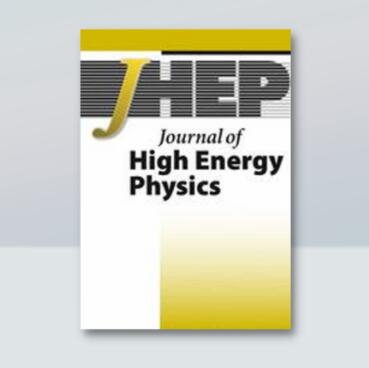在11.7 T磁体中高温超导腔的RADES轴子搜索结果
IF 5.4
1区 物理与天体物理
Q1 Physics and Astronomy
引用次数: 0
摘要
我们描述了在欧洲核子研究中心用11.7 T偶极磁体进行的光晕轴子搜索的结果。搜索使用了一个定制的射频腔,上面涂有高温超导带。对谐振频率约为8.84 GHz的一组27小时的数据进行了分析。在轴子质量36.5676 μeV ~ 36.5699 μeV范围内,宽度为554 kHz,未发现类轴子粒子存在的信号过量。相应的,在此质量范围内,轴子-光子耦合强度的极限设定在gaγ≥6.3 × 10−13 GeV−1和gaγ≥1.59 × 10−13 GeV−1之间,置信水平为95%。本文章由计算机程序翻译,如有差异,请以英文原文为准。
RADES axion search results with a high-temperature superconducting cavity in an 11.7 T magnet
We describe the results of a haloscope axion search performed with an 11.7 T dipole magnet at CERN. The search used a custom-made radio-frequency cavity coated with high-temperature superconducting tape. A set of 27 h of data at a resonant frequency of around 8.84 GHz was analysed. In the range of axion mass 36.5676 μeV to 36.5699 μeV, corresponding to a width of 554 kHz, no signal excess hinting at an axion-like particle was found. Correspondingly, in this mass range, a limit on the axion to photon coupling-strength was set in the range between gaγ ≳ 6.3 × 10−13 GeV−1 and gaγ ≳ 1.59 × 10−13 GeV−1 with a 95% confidence level.
求助全文
通过发布文献求助,成功后即可免费获取论文全文。
去求助
来源期刊

Journal of High Energy Physics
物理-物理:粒子与场物理
CiteScore
10.30
自引率
46.30%
发文量
2107
审稿时长
1.5 months
期刊介绍:
The aim of the Journal of High Energy Physics (JHEP) is to ensure fast and efficient online publication tools to the scientific community, while keeping that community in charge of every aspect of the peer-review and publication process in order to ensure the highest quality standards in the journal.
Consequently, the Advisory and Editorial Boards, composed of distinguished, active scientists in the field, jointly establish with the Scientific Director the journal''s scientific policy and ensure the scientific quality of accepted articles.
JHEP presently encompasses the following areas of theoretical and experimental physics:
Collider Physics
Underground and Large Array Physics
Quantum Field Theory
Gauge Field Theories
Symmetries
String and Brane Theory
General Relativity and Gravitation
Supersymmetry
Mathematical Methods of Physics
Mostly Solvable Models
Astroparticles
Statistical Field Theories
Mostly Weak Interactions
Mostly Strong Interactions
Quantum Field Theory (phenomenology)
Strings and Branes
Phenomenological Aspects of Supersymmetry
Mostly Strong Interactions (phenomenology).
 求助内容:
求助内容: 应助结果提醒方式:
应助结果提醒方式:


